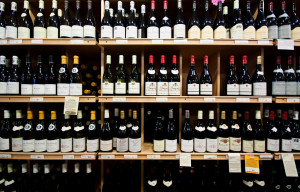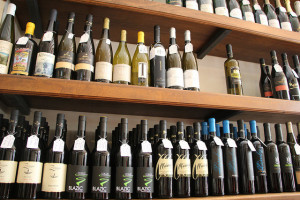So, you want to buy a bottle of wine. You walk into the wine shop, grocery store, or wherever wine is sold where you live and observe the selection. More often than not, you’re met with aisle upon aisle of hundreds
if not thousands of bottles. How does that make you feel? Are you overwhelmed? Exhilarated? Indifferent?
In retail, people can become overwhelmed by the selection to choose from, or what is otherwise known as “choice overload”. Studies in many different retail settings have shown that choice overload does exist and that it can lead to decreased customer satisfaction and decreased sales for a given store. In wine, however, the concept of choice overload has not been tested in a scientific setting until now.
Choice overload was first defined in the 1970s by Alvin Toffler, who stated that it occurs when “the advantages of diversity and individualization are canceled by the complexity of buyer’s decision-making process”. In other words, having a diverse selection of items confuses the consumer so much that they can no longer make a decision at all.
One example of choice overload in a retail setting was done in 2000 using jams in a supermarket. When consumers were given a choice of 6 different jams, 30% of them ended up purchasing at least one of them. When the choice was increased to 24 different jams, only 3% of the consumers purchased a jar, reducing the potential sales by 90%.
The idea of choice overload is further complicated when the consumer is no longer purchasing for themselves but instead is purchasing for someone else. In a very small study (only 68 participants) in two wine shops in NYC, customers who were purchasing for themselves reported greater satisfaction at the smaller wine shop while customers who were purchasing for someone else reported greater satisfaction at the larger wine shop. While this study did not look at choice overload explicitly, it does raise the question of whether or not it does exist in the wine retail setting.
As a result of the vast evidence in the retail setting in support of choice overload, a new working paper from the American Association of Wine Economists aimed to examine this phenomenon in the wine retail setting.
Several hypotheses were tested based on observations and analysis of other goods:
- The more wines available for purchase in a store, the lower the customer satisfaction.
- The more wines available for purchase in a store, the more difficult it will be for a customer to make a selection.
- The more wine knowledge a customer has, the higher the threshold for choice overload (i.e. more knowledge = can tolerate many more wines for selection).
- The more comfortable and satisfied a customer is with a particular store, the higher the threshold for choice overload (i.e. more devoted clientele will not be as phased by a larger selection than someone who shops around).
Methods
This study had three parts:
- The first was using a self-reported questionnaire to determine consumer purchase behaviors and attitudes and how they know and understand the concept of choice overload.
- The second was an observational study in a wine shop to determine how they actually behaved in a wine retail setting.
- The third and final part was a live interview segment with some of those observed in the wine retail setting to determine how comparable their self-reported behavior was to their actual behavior in the shop.
The Questionnaire
The questionnaire utilized in this study asked many questions regarding wine purchase attitudes and
behaviors, including but not limited to how they browse and choose wine in a shop, if they ask for help or choose wine on their own, and how many bottles they typically purchase per visit.
Questions also asked were related to intent to purchase (i.e. did they come into the store knowing what they wanted), and how long they typically spent in the shop.
4000 surveys were sent out using email information from wine retailer’s databases at 9 different stores in the greater NYC area (NY, NJ, and CT). In order to get an accurate representation of the sample at a 95% confidence interval, they would need to receive at least 843 completed surveys back.
The Observations
For the interviews, three of the nine stores in the greater NYC area were chosen to try and get an accurate representation of the wine consumers in that area. Specifically, one store from each state of NY, NJ, and CT were selected.
Researchers used tracking and timing sheets to observe the behavior or each consumer through the wine shop. Additional information collected was the total time spent in the store, the time spent in each section of the store, and whether or not the consumer interacted with any staff at all.
Details regarding how the customer traveled through the store, how many and which bottles were touched, and how many/which bottles were ultimately placed in the cart for purchase were also noted.
Behavior based around a small subset of wine types were chosen for a more detailed analysis: Zinfandel, Cabernet Sauvignon-based wines, red Bordeaux, Pinot Grigio, and Argentinian wines.
Researchers made a note to attempt to observe at least 100 random customers.
The Interviews
Interviews were conducted after customers were seen to have made a purchase and were approached by researchers outside of the store.
Questions asked were related to if they knew what wine they wanted when they walked in, how satisfied they were with the wine they purchased, how satisfied they were with the store overall, their guess on how many wines they had to choose from before settling on the one(s) they purchased, and their perceived wine knowledge.
Results
The Questionnaire
- Out of 4,000 surveys emailed, 806 were received completed (note: 843 were needed to achieve a 95% confidence interval, so the sample size ended up being a little on the small side).
- Most of the respondents self-reported as being high frequency wine consumers.
- 57% of respondents reported purchasing wine bi-weekly or more.
- 50% of respondents reported purchasing at least four bottles of wine at each visit.
- 86% of respondents reported having plenty of time to browse the selection of wines at the shop.
- 70% of respondents “totally disagreed” with the statement that having too many choices in the wine shop makes it more difficult to choose the wine they want, while only 5% “totally agreed”.
- 83% of respondents self-reported as being happy with the selections at the wine shop.
- 14% of respondents wanted a greater selection at the wine shop.
- 3% of respondents wanted a more limited selection at the wine shop.
- Even those that reported a greater difficulty choosing a wine or those that were pressed for time, still reported being satisfied with the selection at their wine shop.
- Bordeaux wines were reported to be purchased less frequently and were not as well understood in terms of their taste.
- Respondents did report an interest in learning more about Bordeaux wines.
- Respondents also reported an interest in learning more about Argentinian wines.
- Those wanting to learn more about Argentinian wines expressed interest in a greater selection of Argentinian wines in the shop.
- Red Zinfandel was reported as not purchased very much.
- Cabernet Sauvignon-based wines were reported to be purchased in high frequency, though respondents also noted they were not interested in learning more about these types of wines.
- Pinot Grigio wines were reported to be purchased in high frequency, though respondents also noted they were not interested in learning more about these types of wines.
- Respondents reported wanting less of a selection of Pinot Grigio wines in the wine shop, even though Pinot Grigio was found to be the largest single category of wine sales at the shops in focus.
- In a nutshell, no choice overload was determined to exist based upon questionnaire responses.
The Observations
- Participants self-reported higher wine purchases than actually observed in real-time.
- Participants self-reported much longer time to shop than they actually did in real-time.
- Note: questionnaire participants were likely different people than those randomly selected at the store, so there could be differences between the two populations based on that fact alone.
- 30% of customers were observed to ask for help in the shop (which mostly matched the self-reported questionnaire group at 25%).
The Interviews
- 119 interviews were performed.
- Nearly all interviewees reported satisfaction with their wine choice (only 3 people reported less than a 7 out of 10 satisfaction level).
- The store with the largest selection of wines had the highest overall store satisfaction rate and was tied for the best wine selection satisfaction rate.
- There was a negative relationship between number of choices and the time it took to select a wine (i.e. the greater the number of wines to choose from, the less time it took to choose a wine).
- There was no correlation between reported wine knowledge level and satisfaction rate.
- In a nutshell, no choice overload was determined to exist based upon interview responses.
Conclusions
Overall, the results of this study indicate that choice overload does not exist in the wine retail setting.
Despite these results, I am not too keen to accept them with much confidence. While the concept of the study was certainly fascinating and has the potential to be useful in the wine retail/marketing setting, there are several problems with this study that negate my ability to say with confidence that choice overload does not exist in the general wine retail setting.
First: The sample size was too small. The researchers said it themselves that they needed 843 responses in order to achieve a 95% confidence interval for the questionnaire portion of the study, but received only 806 instead.
In order to accept or reject any of the three hypotheses at the 95% confidence interval (the accepted interval for basically all respectable scientific research), you need to have a certain number of study subjects. Based on the numbers crunched by the researchers in this study, that number was 843.
Since they did not achieve this number, the overall power of the study is too low and thereby statistically they are neither able to accept or reject the hypothesis regardless of what results were seen. They say there is no evidence of choice overload based on the questionnaires, however, since their sample size was too low and they did not have enough power, there is no way they can even say that. All they can say is that there is no choice overload for the 806 individuals surveyed, but that’s it.
Second: The participants in the study were not a representative sample of the total American wine consumer population.
In fact, 57% of respondents were categorized as “high frequency wine consumers”. According to a recent Wine Market Council report, only 33% of wine consumers in the US are considered to be high frequency wine consumers, indicating that the sample population for this study was skewed and not representative of the whole.
This means that any of the results of this study cannot be generalized to the overall population, since the sample population does not reflect the general population on a wine purchase frequency level. Even if the sample size were large enough to carry statistically weight, all we could say based on these results is that there is no apparent choice overload noted in high frequency wine consumers in the greater NYC area.
Third: The selection method.
For an exploratory study, the participant selection method was probably sufficient, however, there is likely to be great bias and thus difficulty in extrapolating results to a larger consumer base.
In general, participants were selected based on email lists from nine different wines stores. It’s highly possible that many of those people on that list are already bias toward that one particular store, making discerning the difference between possible choice overload and simple loyalty to that particular store much more difficult.
Selection of individuals from many different types of stores (i.e. supermarkets, wine shops, liquor stores, etc.) or sending people into stores they have never been to or heard of before might help reduce the conflicts of interest in this case.
Overall, I thought the premise of this study was very interesting and would be a valuable addition to the information on choice overload research in general. Taking the researchers at their word, it would seem that choice overload does not exist in the wine retail setting whereas it does exist with other goods.
However, due to the poor power and statistical strength of this study, combined with the poor representation of the true wine consumer population in the United States, I think the jury is still very much out and more research needs to be done on this subject.
What do you all think of this study? Please feel free add to the discussion by leaving your comments below!
Source:




12 comments for “How Much is Too Much?: A Study on Choice Overload in Wine Retail”